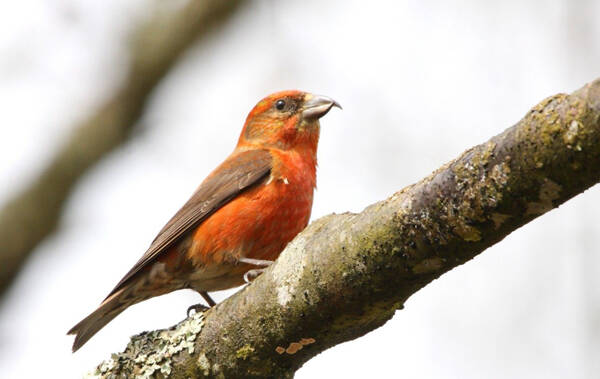Loxia curvirostra
IUCN
LCBasic Information
Scientific classification
- name:Loxia curvirostra
- Scientific Name:Loxia curvirostra,Common Crossbill,Crossbill, Green Crossbill
- Outline:Songbird
- Family:Passeriformes Passeridae Crossbills
Vital signs
- length:14-17cm
- Weight:28-48g
- lifetime:About 15 years
Feature
Both sexes have large, pointed, crossed mouths
Distribution and Habitat
Origin: Albania, Algeria, Andorra, Armenia, Austria, Azerbaijan, Belarus, Belgium, Belize, Bermuda, Bhutan, Bosnia and Herzegovina, Bulgaria, Canada, China, Croatia, Cyprus, Czech Republic, Denmark, El Salvador, Estonia, Faroe Islands, Finland, France, Georgia, Germany, Greece, Guatemala, Honduras, Hungary, Islamic Republic of Iran, Ireland, Israel, Italy, Japan, Kazakhstan, Democratic People's Republic of Korea, South Korea, Kyrgyzstan, Latvia, Liechtenstein, Lithuania, Luxembourg, Macedonia, Mexico, Mongolia, Montenegro, Morocco, Myanmar, Nepal, Netherlands, Nicaragua, Norway, Philippines, Poland, Portugal, Romania, Russian Federation, Saint Pierre and Miquelon, Serbia, Slovakia, Slovenia, Spain (Galari), Sweden, Switzerland, Tunisia, Turkey, Ukraine, United Kingdom, United States, Uzbekistan and Vietnam.
Wandering: Afghanistan, Greenland, Iceland, Jordan, Libya, Malta, Svalbard and Jan Mayen, Tajikistan.
In China, it is found in the Lesser Khingan Mountains in the northea
Appearance
The male Red Crossbill has a vermilion forehead, top of the head and nape in summer, with brown or olive-brown feather bases, which are often partially exposed to the outside, so that there are often some gray-brown or straw-yellow spots on the forehead and top of the head. The front of the eyes, around the eyes, and ear feathers are dark brown or dark reddish brown, and there is a vermilion spot from the front of the ear feathers to the base of the beak. The back, shoulders, and sides of the neck are gray-brown, with vermilion feather edges and feather tips, sometimes stained with olive red. The waist and upper tail coverts are bright vermilion, and the upper tail coverts are black-brown. The tail is also black-brown with reddish-brown feather edges, and the tail feathers are concave at the end. The upper wing coverts are dark brown with wide light vermilion-brown end edges. The flight feathers are black-brown with yellow-brown or brown-red feather edges. The chin, throat, chest, uppe
Details
Common Crossbill, also known as Common Crossbill, is a small swallow with 19 subspecies.

Common Crossbill wanders in winter and some birds migrate in groups. It is sexually active and likes to gather in groups. Except for the breeding period, it moves alone or in pairs. In other seasons, it gathers in groups, especially in places with abundant food, often in large groups of dozens or even hundreds of individuals. It jumps between pine branches with cones to forage for cones. It can also climb between pine branches or hang on branches with its mouth. Sometimes it also goes down to the ground to move and forage. When flying, its wings flap vigorously, fast, and in a shallow wave. It often sings while flying, and its song sounds loud, like "Jio-Jio-Jio".
Red crossbills mainly feed on seeds of conifers such as larch, red spruce, fish-scale spruce, stinking spruce, stinking fir, and red pine. It especially likes to eat larch nuts. It also eats seeds and fruits of other trees and shrubs such as red pine nuts, hazelnuts, leaves, inflorescences, berries, grass seeds, and insects. Sometimes they hang upside down to eat, cracking pine nuts with their cross-billed beaks. When eating cones, they first peck off the pine cones, step on the branches with their feet, and then peck open the fruit scales to eat the seeds. The cross-billed beaks can easily tear the seed coat.
The breeding season of the red crossbill is from May to August. In mid-July, they start to move in pairs, and both males and females look for nesting sites. The nest is located on the side branches of tall trees in the dense forest of red pine and larch mixed with spruce, more than 20 meters above the ground. The nest is bowl-shaped and is woven from larch and spruce twigs, mosses, lichens, etc. There are 3-5 eggs in a nest, and the shell color is dirty white with light green, decorated with purple-gray base spots and reddish brown and black spots. The female bird is responsible for incubation. During the incubation period, the male bird feeds the female bird. The incubation period is 17 days. The parents raise their chicks with larch seeds, and they leave the nest after 14-18 days. In autumn, the young birds mix with the old birds, form groups, and migrate south from the breeding grounds.
Listed in the "National List of Terrestrial Wildlife with Important Economic and Scientific Research Value" (Item 665) issued by the State Forestry Administration of China on August 1, 2000.
Listed in the "Red List of Endangered Species of the World Conservation Union" (IUCN) 2017 ver 3.1-Least Concern (LC).
Listed in the second level of China's "National Key Protected Wildlife List" (February 5, 2021).
Protect wild animals and stop eating game.
Maintaining ecological balance is everyone's responsibility!








